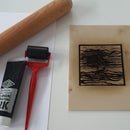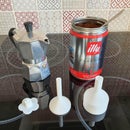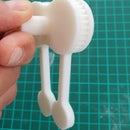Introduction: Nuclear Switch Locator
Yes, I know... the title is kind of an exaggeration but not quite :) This instructable aim to solve a problem that troubled humans since the invention of the electric light: how do you find a light switch in the dark? "Just buy an illuminated light switch!" you will say... but where's the fun in that?
I came up with a solution that requires a 3D printer, a little bit of blue tack and a couple of... radioactive gas filled vials.
These sealed glass vials are internally coated with a phosphor material and filled with tritium, a radioactive isotope of hydrogen that emits beta particles (electrons). Tritium emits electrons through beta decay and, when they interact with a phosphor material, light is emitted through the process of phosphorescence: they will glow continuously for about 20 years!
The overall process of using a radioactive material to excite a phosphor and ultimately generate light is called radioluminescence.
Supplies
- tritium vials (2 of)
- 3D printed part
- blue tack
This is it!
Step 1: Let's Do It!
Building this device is extremely easy and will require just a few minutes:
- download the 3D model (available as STL or STEP file should you want to modify it).
- print the 3D model.
- insert a tiny amount of blue tack into the slots that will host the vials in order to secure them
- insert the vials in the slots, gently pushing them. They should not protrude from the surface.
- put some bluetack on the back of the 3D printed part.
- secure your nuclear switch locator on the switch plate and...
...FIAT LUX! Job done
For the next 20 years you will be able to find your light switch without staining the wall around it randomly moving your hands it in the dark... :)
Step 2: Safety and Legislation
Safety
A 2007 report by the UK government's Health Protection Agency Advisory Group on Ionizing Radiation declared the health risks of tritium exposure to be double than previously set by the International Commission on Radiological Protection, but encapsulated tritium lighting devices, typically taking the form of a luminous glass tube embedded in a thick block of clear plastic, prevent the user from being exposed to the tritium at all unless the device is broken apart.
Tritium presents no external beta radiation threat when encapsulated in non-hydrogen-permeable containers due to its low penetration depth, which is insufficient to penetrate intact human skin. However, GTLS devices do emit low levels of X-rays due to bremsstrahlung. The primary danger from tritium arises if it is inhaled, ingested, injected, or absorbed into the body. This results in the absorption of the emitted radiation in a relatively small region of the body, again due to the low penetration depth. The biological half-life of tritium—the time it takes for half of an ingested dose to be expelled from the body—is low, at only 12 days. Tritium excretion can be accelerated further by increasing water intake to 3–4 liters/day.
Direct, short-term exposure to small amounts of tritium is mostly harmless. If a tritium tube breaks, one should leave the area and allow the gas to diffuse into the air. Tritium exists naturally in the environment, but in very small quantities.
Legislation
Because tritium is used in boosted fission weapons and thermonuclear weapons (though in quantities several thousand times larger than that in a keychain), consumer and safety devices containing tritium for use in the United States are subject to certain possession, resale, disposal, and use restrictions. In the US, devices such as self-luminous exit signs, gauges, wristwatches, etc. that contain small amounts of tritium are under the jurisdiction of the Nuclear Regulatory Commission, and are subject to possession, distribution, and import and export regulations found in 10 CFR Parts, 30, 32, and 110. They are also subject to regulations for possession, use, and disposal in certain states. Luminous products containing more tritium than needed for a wristwatch are not widely available at retail outlets in the United States.
They are readily sold and used in the UK and US. They are regulated in England and Wales by environmental health departments of local councils. Tritium lighting is legal in most of Asia and Australia.
(courtesy of Wikipedia)






